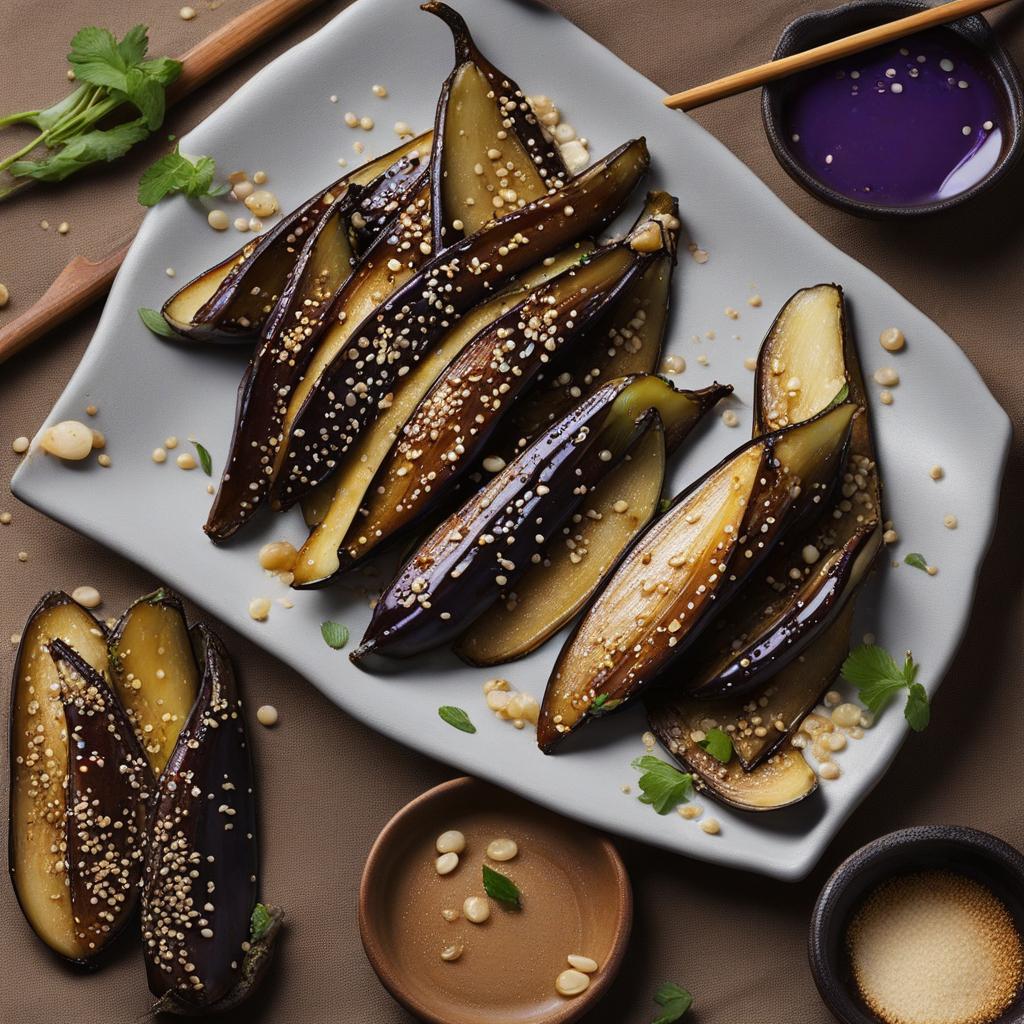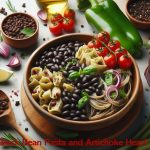Do you want something tasty and healthful to eat? You’ve found it! We’ll look at the best “Recipe for Japanese Eggplant Roasted” in this post. This easy-to-make but delicious recipe will help you showcase the savory, rich flavor of Japanese eggplant. Explore the realm of delectable tastes as we uncover the secrets of flawlessly roasted Japanese eggplant!
Page Contents
ToggleThe Ideal Recipe for Roasted Japanese Eggplant
Main Components:
Japanese Olive Oil for Eggplants
- Sauce Soy
- In Mirin
- Mustard Oil
- Grated ginger, minced garlic,
- Add pepper and salt to taste.
- Peanuts (as a garnish)
Guidelines for Roasted Japanese Eggplant:
- Set oven temperature to 400°F, or 200°C.
- Clean the Japanese eggplant and cut it lengthwise.
- To make a tasty marinade, combine olive oil, soy sauce, mirin, minced garlic, grated ginger, salt, and pepper in a bowl.
- Make sure that all of the sliced eggplant is thoroughly coated by generously brushing it with marinade.
- Spread the eggplant slices on a baking sheet and roast, turning halfway through, for 20 to 25 minutes, or until golden brown.
- For the ideal finishing touch, after roasting, drizzle with sesame oil and sprinkle with sesame seeds.
Food Worth:
Japanese eggplant has a lot of nutrients in addition to being delicious. It is a great option for a healthy diet because it is high in fiber and low in calories. The roasted variety offers a distinct smoky flavor while preserving vital nutrients. Rich in vitamins, minerals, and antioxidants, this dish supports general health.
Advantages:
Japanese eggplant is a healthy choice because it is high in fiber and low in calories, making it a part of a balanced diet.
Rich in Nutrients:
The dish’s nutritional value is preserved by the eggplant, which supplies vital vitamins and minerals.
Versatile Flavor:
Soy sauce,mirin,and sesame oil come together to produce a delicious umami flavor that goes well with a variety of dishes.
Drawbacks
Texture Sensitivity:
If roasted eggplant isn’t cooked to perfection, some people might not find its texture to be as appealing.
Allergy Alert:
Make sure visitors aren’t allergic to any of the components, particularly the soy sauce or sesame seeds.
As we come to the end of our culinary exploration, this recipe for perfectly roasted Japanese eggplant offers your taste buds more than just a meal. This recipe lets you enjoy the flavors of Japanese cuisine in the comfort of your own home with a harmonious blend of flavors and ease of preparation. Savor the rich, umami flavor and smoky aroma that characterize this delicious dish as soon as you take that first bite. This recipe will become a mainstay in your repertoire, delighting every palate it touches, regardless of your level of culinary experience. Take your eating to the next level and start this never-ending journey of crafting delicious moments with every perfectly roasted Japanese eggplant slice.
FAQ
Most frequent questions and answers
Can I use regular eggplant instead of Japanese eggplant?
Regular eggplant can be substituted, but Japanese eggplant works well in this recipe because of its milder flavor and slender shape.
Can I skip the mirin in the marinade?
A hint of sweetness and depth is added by the mirin. You can leave it out if it’s not available, but it adds to the flavor profile overall.
How do I ensure the eggplant is perfectly roasted without burning?
Pay special attention to the oven. Roast for 1 hour at 400°F (200°C), turning once. Adapt the time according to how well your oven works.
Can I prepare this dish ahead of time?
Definitely! When the eggplant is ready, marinate it ahead of time and roast it. For busy schedules, it’s a great make-ahead option.
Any suggestions for improving the dish even more?
For an added personal touch, try experimenting with extra herbs like basil or thyme. The flavors can also be enhanced with a squeeze of lemon or a sprinkle of feta.
Is this recipe suitable for a vegan diet?
The recipe is totally vegan, yes. Make sure the mirin and soy sauce you buy are vegan-friendly brands.
Can I grill the eggplant instead of roasting it?
Definitely! Charring imparts a deliciously smoky flavor. Apply the marinade, then grill until the food is soft.
What side dishes pair well with roasted Japanese eggplant?
It goes well with rice, quinoa, or as a savory garnish for a summer salad. It goes nicely with many greens and grains.
How long can I store leftover roasted eggplant?
Keep leftovers in the fridge for up to two days in an airtight container. Warm through in the microwave or oven for an easy and delicious meal.
Freezing may alter the texture, but you can freeze it for up to one month. Thaw and reheat in the oven for the best results.
You can freeze it for up to a month, but it might change texture when frozen. For best results, thaw and reheat in the oven.
Nutrition:
This delicious delicacy,Hilltop Steakhouse Lobster Pie, offers a special fusion of flavors and essential nutrients. Here’s a summary of its nutritional worth and the benefits and drawbacks of indulging in this salty dessert.
Advantages:
Full of Protein:
If you’re trying to maintain or gain muscle, lobster is a fantastic option because it’s a wonderful source of lean protein. About 25 grams of protein can be found in a 3.5-ounce portion of lobster meat.
Low in Fat:
Saturated fat, in particular, is not present in a lot of lobster. This means that you can enjoy it without worrying about consuming too much fat because it’s a heart-healthy alternative.
Minerals and vitamins:
B vitamins, including B12, zinc, and selenium are among the vital minerals and vitamins found in lobster. B12 is necessary for healthy nerves, and zinc and selenium are important for immune system function and general well-being.Lobster is an excellent source of omega-3 fatty acids, which have been linked to a number of health advantages, including the reduction of inflammation, enhancement of heart health, and promotion of brain function.
Low in Calories:
Although the pastry crust and creamy sauce include calories, the lobster meat provides the majority of the calories. This means you can have a nice lunch without consuming too many calories.
Delightful and Contenting:
The flaky pastry crust together with the rich, creamy texture of the lobster pie creates a really filling dinner that can quell your cravings and offer comfort.
Drawbacks:
High in Cholesterol:
Due to their natural high cholesterol content, lobster may be unsuitable for anyone with cholesterol-related medical conditions. It is suggested that people with high cholesterol consume lobster in moderation.
Caloric Density:
The dish’s caloric density can be considerably increased by the addition of butter, heavy cream, and pastry dough, which makes it less suited for people following a strict calorie-restricted diet even though the lobster meat itself has a relatively modest calorie count.
Allergies:
Some people may have a shellfish allergy, which includes lobster. If you have a known shellfish allergy, it’s crucial to be aware of potential allergens and stay away from this dish.
Lobster pie from Hilltop Steakhouse is a delectable treat that provides a healthy mix of vital nutrients and protein. Although it has several health advantages, you should be aware of its greater sodium, cholesterol, and calorie content. Enjoy this delectable New England favorite in moderation, as with any dish, and be mindful of your nutritional needs and any particular health problems or health risk.
As an Amazon Associate I earn from qualifying purchases.




cialis no consultation
Tasty Japanese Eggplant Roast: An Ideal Recipe for Pleasure